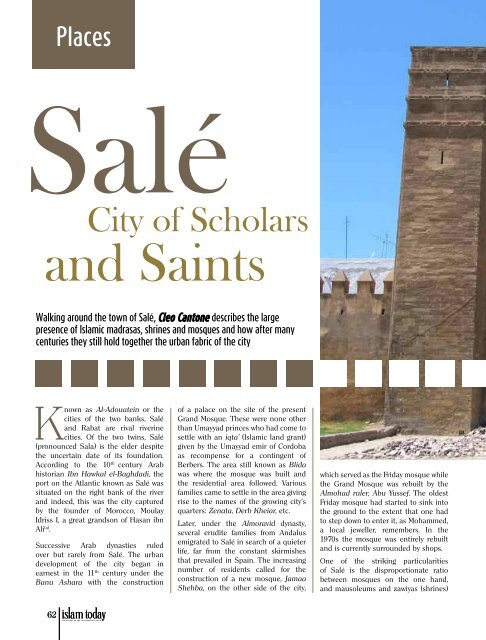You also want an ePaper? Increase the reach of your titles
YUMPU automatically turns print PDFs into web optimized ePapers that Google loves.
PlacesSaléCity of Scholarsand SaintsWalking around the town of Salé, Cleo Cantone describes the largepresence of Islamic madrasas, shrines and mosques and how after manycenturies they still hold together the urban fabric of the cityKnown as Al-Adouatein or thecities of the two banks, Saléand Rabat are rival riverinecities. Of the two twins, Salé(pronounced Sala) is the elder despitethe uncertain date of its foundation.According to the 10 th century Arabhistorian Ibn Hawkal el-Baghdadi, theport on the Atlantic known as Salé wassituated on the right bank of the riverand indeed, this was the city capturedby the founder of Morocco, MoulayIdriss I, a great grandson of Hasan ibnAli (a) .Successive Arab dynasties ruledover but rarely from Salé. The urbandevelopment of the city began inearnest in the 11 th century under theBanu Ashara with the constructionof a palace on the site of the presentGrand Mosque. These were none otherthan Umayyad princes who had come tosettle with an iqta’ (Islamic land grant)given by the Umayyad emir of Cordobaas recompense for a contingent ofBerbers. The area still known as Blidawas where the mosque was built andthe residential area followed. Variousfamilies came to settle in the area givingrise to the names of the growing city’squarters: Zenata, Derb Kheiar, etc.Later, under the Almoravid dynasty,several erudite families from Andalusemigrated to Salé in search of a quieterlife, far from the constant skirmishesthat prevailed in Spain. The increasingnumber of residents called for theconstruction of a new mosque, JamaaShehba, on the other side of the city,which served as the Friday mosque whilethe Grand Mosque was rebuilt by theAlmohad ruler, Abu Yussef. The oldestFriday mosque had started to sink intothe ground to the extent that one hadto step down to enter it, as Mohammed,a local jeweller, remembers. In the1970s the mosque was entirely rebuiltand is currently surrounded by shops.One of the striking particularitiesof Salé is the disproportionate ratiobetween mosques on the one hand,and mausoleums and zawiyas (shrines)on the other: the latter outnumber theformer at least ten to one. The city’s twomost imposing mausoleums belong totwo towering saintly figures: Sidi ‘AdbAllah ben Hassoun (d. 1604) known assultan al-bled (sultan of the country)and Sidi Ahmad ben Ashir (d.1362/4)or al-Tbib (the Doctor).A series of minor funerary monuments,like the Sufi paths or tariqas, lead to theunifying place of worship embodied bythe Great Mosque. It is this relationshipbetween the constellation of Sufi shrinesand the monumental main mosque thatholds together the urban fabric of thecity where other activities, namely thelocal crafts, now sadly demised, used toflourish.When I have asked a passer-by toidentify the zawiya or mausoleum Ihappen to be photographing, the wordshirk has been uttered to indicatethe disapproval of visiting saints’shrines. The very fact that many arerenovated and maintained indicatesthat popular devotion to these placeshas not altogether vanished. Althoughthis is not the place to discuss thereligious validity of visiting shrines,what cannot be discounted is their rolein strengthening faith communitiesand offering alternative help notalways affordable or available throughmore conventional channels. Elusiveconditions such as schizophreniahave continued to receive attentionfrom ‘traditional healers’ as opposedto medical doctors. Sidi ben Asherwas in fact known for his healing gift,6263


